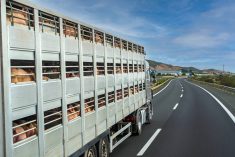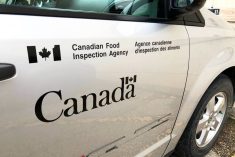Combined federal and provincial funds will allow Saskatchewan to compensate its livestock producers for animals killed or injured by predators.
The province on Thursday rolled out “overall enhancements” to its wildlife damage compensation program, managed by its crop insurance corporation.
Under the enhanced program, producers can expect to be compensated for 100 per cent of the market value of livestock killed by predators, and “up to 80” per cent of the market value for injured livestock requiring veterinary services.
Compensation will be issued for either death or injury of “cattle, sheep, goats, bison, horses, domesticated hogs, elk, fallow deer, llamas, donkeys, ostriches, emus, chickens, ducks, geese, turkeys and other less common species,” the province said Thursday.
Read Also

U.S. livestock: ‘Cattle on feed’ report supports prices
Chicago cattle futures rose as the USDA’s ‘Cattle on Feed’ report showed inventories two per cent down from a year…
The program will cover death or injury caused by coyotes, bears, cougars, lynx, foxes, eagles and/or wolves, the province said.
The level of compensation will be based on market prices, but will include a minimum of $400 for calves, $40 for sheep and $30 for goats.
Furthermore, the program will now also include compensation for wildlife damage to crops and feed used for swath, bale and corn grazing, the province said in its release.
Full compensation for wild boar damage to crops is also to be added to the program.
As well, the previous $5,200 per yard site compensation limit for wildlife damage to stacked feed in a yard site will be removed, the province said.
The federal and Saskatchewan governments have pledged a cost-shared total of $2.5 million per year to pay for the improvements, which take effect April 1.
“This change will make sure crop insurance is there for producers when a calf is taken down by coyotes or some swaths are pulled apart by deer,” said federal Agriculture Minister Gerry Ritz, a western Saskatchewan MP.
While Saskatchewan Crop Insurance Corp., based at Melville, administers the compensation program, there are no premiums and producers don’t have to be SCIC customers to be eligible for benefits.
The change also commits SCIC to a “larger role” in preventing wildlife damage, as it will now also take over administration of the province’s existing Livestock Predation Program, which was developed to manage problem predators and educate producers on predation issues.
“Significant impact”
“Wildlife damage to both crops and livestock has become an increasing concern for our members,” David Marit, a councillor from the R.M. of Willow Bunch and president of the Saskatchewan Association of Rural Municipalities, said in the province’s release.
“We commend the federal and provincial governments for acknowledging this problem, improving the program and taking steps to help producers protect their investments.”
“Livestock predation and wildlife damage to fall and winter grazing operations can have a significant impact on a producer’s bottom line,” Saskatchewan Cattlemen’s Association chairman Jack Hextall said in the same release, noting that “in this industry every dollar counts.”
“Many sheep producers have suffered significant losses due to coyotes and other predators,” Saskatchewan Sheep Breeders Association board member Martin Catto of Lipton said in the same release, calling the changes “a definite move forward to assist sheep producers.”














